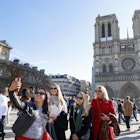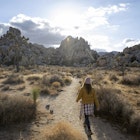
Oct 31, 2024 • 5 min read

Feb 11, 2020 • 6 min read

On a hot summer’s day in Arlington, Texas, I’m walking through a small, little-known cemetery. Gold-embossed lettering glitters from black marble tombs. Colourful bunches of flowers, some with tear-stained notes, dot the narrow path. But – thankfully – I’m not here to grieve for a recently-passed family member; which begs the question, what exactly am I doing here?

Like many travellers, I’m drawn to cemeteries. They’re places that bridge the void between the present and the past, the living and the dead. They can be major attractions, too: Père Lachaise in Paris receives 3.5 million visitors per year, roughly the same as the Musée d’Orsay.
But how should we conduct ourselves in a place where the dead slumber? And are there situations when we should let them rest in peace? Here’s a guide to ethical cemetery tourism for curious travellers.

When you’re surrounded by beauty – and by other tourists – it can be easy to forget you’re in a place of mourning. Visitors to London’s Highgate Cemetery wander around in a reverie, gazing at angel statues and ivy crawling across tombs. At Hollywood Forever Cemetery in Los Angeles, the atmosphere is almost upbeat, with zany mausoleums of silver-screen royalty and occasional movie screenings. But many necropolises on the tourist trail are still working cemeteries (that is, accepting new burials).
"When you are visiting a functioning cemetery there may be mourners there for whom their loss is very raw,’" says H E Sawyer, author of I Am The Dark Tourist, a book based on decades of experience visiting sites associated with death. "So I tend to tread very gently and carefully, especially overseas where I don't know local customs or [am] not fluent in the language."
It’s a good rule of thumb to behave as you would when visiting a place of worship. You wouldn’t wear hot pants to a mosque or let your dog roam unleashed inside a church, and cemeteries invite a similar level of respect. Be wary about taking cues from behaviour around you: people picnicking by a war monument might be clueless tourists poised to cause offence, while the person sitting on a tombstone might be visiting a loved one’s grave. It’s also important to be thoughtful before snapping pictures.
"I am always mindful not to have any other visitors in the frame," says Dr Peter Hohenhaus, the creator of dark-tourism.com, a compendium of almost 900 cemeteries, war memorials and other dark destinations. "If a photo captures names on tombstones, I make sure to edit these out in Photoshop (or similar) afterwards, if I decide to use the image in public."

In burial sites associated with large-scale tragedies, from the Somme’s military cemeteries to Cambodia’s Killing Fields, the question of ethical photography looms even larger. For Dagney McKinney, one of the creators of Cultura Obscura, a travel blog dedicated to macabre destinations, there’s one kind of photo in particular that is best avoided: the selfie.
"Taking a selfie in front of the ossuary at the Killing Fields, which explicitly requests that tourists do not take selfies, isn’t about showing your respect for the victims, it’s about trying to prove you were there," says McKinney. "It shouldn’t be a proud moment in your family album, or part of your curated Instagram feed. Ultimately, your motivations for taking the selfie matter."
The Khmer Rouge regime murdered 1.7 million people and tens of thousands are buried at the Killing Fields. With visitor numbers rising, the site is a prime example of ‘dark tourism’, the practice of touring places associated with death or tragedy.
Before visiting any dark tourism site, educate yourself about the conflict or tragedy. Make efforts to understand its meaning to local people. At locations such as the Killing Fields, many visitors find it surreal to encounter souvenir sellers and big groups of camera-toting tourists – the experience can feel morally ambiguous.
"There is a fine blurred line between ethical consumption and exploitative commercialisation within dark tourism," warns Dr Philip Stone, Executive Director at the University of Central Lancashire's Institute for Dark Tourism Research. "Death sells – and always has done!"

It isn’t only historic cemeteries that receive attention from travellers. Online resources like Find A Grave, cataloguing 180 million memorials, facilitate countless personal pilgrimages. With a small amount of research, travellers can seek out the graves of ancestors or individuals they admire. That’s how I ended up walking through Moore Memorial Gardens in Arlington, Texas, visiting the graves of two gone-too-soon musicians.
Like many heavy-metal-obsessed teens in the late ‘90s and early 2000s, I had an almost constant soundtrack of bands like Pantera and Damageplan. The brothers who formed these groups both died suddenly: guitarist Darrell ‘Dimebag’ Abbott was murdered on stage in 2004 and his drummer brother, Vinnie Paul, passed unexpectedly in 2018. So when I found myself driving through Texas, I took a detour to see their graves.
"The whole point of having a tombstone is that there’s something left of you to be seen after death," says Dr Hohenhaus of dark-tourism.com. "And that's not just for relatives; since cemeteries are public places, in theory it’s for everybody to see."
The grave site of the Abbott brothers is a cult pilgrimage place for fans, who come to leave gifts and knock back drinks. At first glance, the guitar picks and bottles left graveside seem like an apt tribute to metallers with legendary lust for life.
But, however powerfully felt, a person’s connection with a musician, artist and even ancestor that they never met, is hazy and abstract. Behaving as though you’re in the presence of mourning family members is a good guide. Is it appropriate to lay flowers? More than likely. How about downing a shot of booze while taking a selfie above the grave? I’d assume less so.
Attitudes towards death and mourning vary, but the key to ethically visiting cemeteries is behaviour that flows from respectful intent. We remember our dead in a multiplicity of ways, and that’s what makes cemeteries so fascinating to explore.

1. Read about cultural norms: Historical context is useful, and if you’re planning to leave offerings or take photos then you need to know local attitudes.
2. Don’t touch: Yes, Oscar Wilde’s tomb is already covered in lipsticked kisses. But don’t contribute to eroding or staining someone’s grand gravestone.
3. Lower the volume: According to some western European superstitions, whistling in a graveyard summons the devil. Perhaps it’s a ruse to ensure visitors maintain a respectful volume.
4. Talk to your travel group: That friend or family member, known for their zany selfies? Reset their expectations (or pocket their phone).
5. Be safe: Shadowy activity isn’t unknown in cemeteries (drug taking, illicit encounters) so take appropriate safety precautions if you’re somewhere remote.
You might also like:
10 lesser-known haunted places around the world
6 US cemeteries to visit the ghosts of the past
Legendary artists' houses you can visit

Solo Travel
20 expert solo travel tips for women from the Lonely Planet teamOct 31, 2024 • 11 min read

Oct 31, 2024 • 5 min read

Oct 24, 2024 • 13 min read






Sep 8, 2024 • 5 min read
